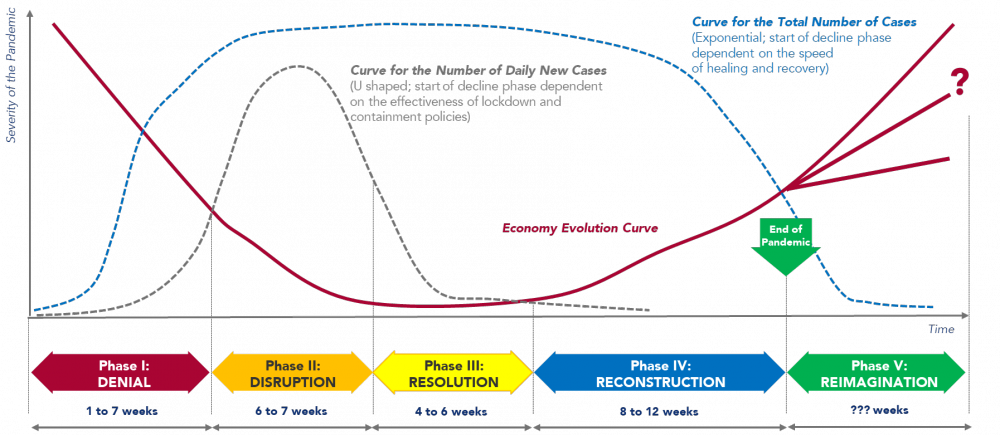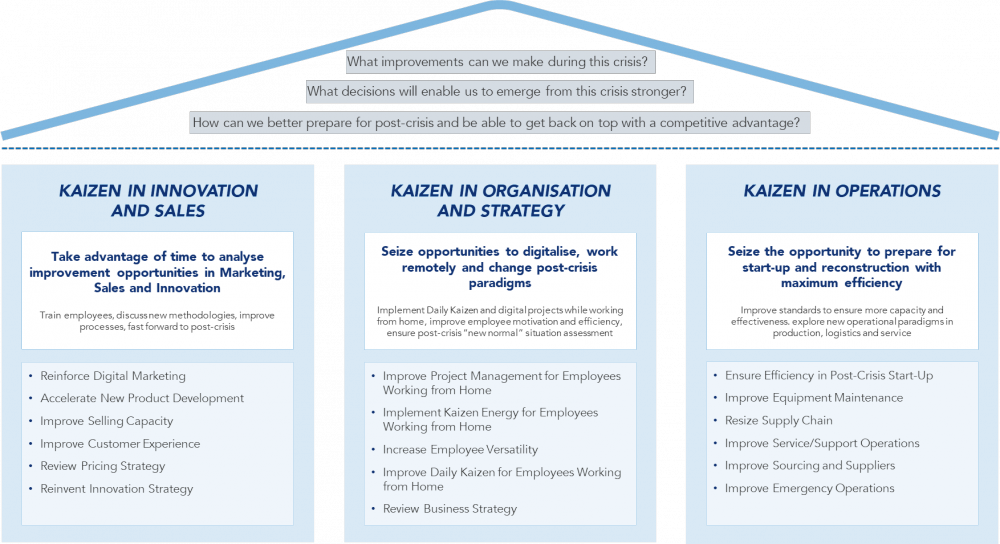The crisis caused by COVID-19 took the world by surprise, causing a disruption in Health Systems and in the global economy.
The current pandemic context throws us into a global public health, economic and social crisis that no one could have predicted.
The beginning of the Pandemic has been characterised by a strong Economic Recession accompanied by uncertainty, a severe drop in demand, a slowing down of supply chains and many organisations closing. The combination of these factors has caused a depressive spiral effect on the economy.
Pandemic Evolution Curve
Based on the evolution of the pandemic in the different countries and the containment policies adopted, assuming that the evolution curve of the economy follows a “U” shape in synchrony with the pandemic curve, it is possible to estimate a baseline scenario of phases and dates for recovery. In this alignment, the evolution of the crisis is plotted in five phases, the first being denial and the last being reimagination. The phases may be longer or shorter depending on the measures implemented and compliance by the population.

Pandemic Evolution Curve and Phases
Phases Model
The first phase – Denial Phase – is the phase that runs from the 1st Case detected to the State of Emergency being declared (Lockdown). It is characterised by a state of denial of the critical nature of the crisis, with the reality of a slowdown in sales and operations gradually becoming more acute, along with the urgent action taken to deal with customer losses.
This is followed by the second phase – Disruption Phase. This takes place from the moment a State of Emergency is declared to the first week of an abrupt drop in new daily cases. Officially the country stops and almost all businesses are affected, creating an urgency to minimise the impact of the stoppage and react in the most sympathetic way. At this phase, the necessary changes are made to maintain operations, by applying the necessary physical restrictions and resorting to remote working.
The third phase is the Resolution Phase, which takes place from the first week of an abrupt fall in cases until the State of Emergency is officially over.
We enter the ” plain” and ” fall” phase, where we begin to talk about the withdrawal of the State of Emergency, and we feel the growing hope of a return to ” normal “. In this phase the preparation of restoration actions and economic and social reconstruction begins.
The fourth phase, the Reconstruction Phase, starts with the end of the State Emergency and lasts until about fifty percent of the Pre-Crisis businesses have recovered. It is characterised by a strong motivation to prevent a new outbreak and to ensure that businesses resume their activity quickly. The implementation of recurrence prevention and recovery measures takes place in this phase, which lasts approximately 3 months.
After the reconstruction phase, with the necessary adaptation of all activities to implement the new rules, the Reimagination Phase will be reached, in which innovation and growth will once again become a priority for business. This phase includes the implementation of actions to ensure a vertical start-up for recovery. It focuses on the process of imagining market and legislative changes and identifying the opportunities of the “new normal”. It becomes vital to review the organisation’s strategy in order to address the new “Change Drivers” that emerge from the crisis.
Improvement Strategy
Competitiveness, based on differentiating advantages, must be developed during all these phases of evolution of the pandemic. The development of people and processes, the focus on innovation and improvement and the preparation for vertical start-up with a strategic response to the “new normal” are some of the key points to ensure an agile, effective and efficient recovery of organisations.

KAIZEN™ Improvement Strategy
KAIZEN™ in Innovation and Sales
The reinforcement of the digital presence as a way of attracting new customers must be implemented, based on a clearly defined Digital Marketing strategy supported by the value for the customer. The Voice of the Customer must be the input, not only for the design of the digital strategy, but also for the reengineering of the processes that influence the customer’s experience and the product characteristics that the customer values and is willing to pay for. The products to be promoted must be adapted to the new social paradigms, therefore it is necessary to create structures for the agile development of new products. With strong marketing and product support, sales teams must also be able to innovate their commercial approach in order to increase conversion rates and win market share.
KAIZEN™ in Organisation and Strategy
Remote work emerges as an opportunity for the digitisation and automation of team management and project management processes. This will lead to the definition of the new “normal” in post-crisis operations. Collaborators will have the opportunity not only to work with new platforms, but also to acquire new skills that will improve the organisation’s flexibility, something crucial for recovery. Considering all the changes implemented in a short period of time, it is important to strengthen the focus on the well-being of the collaborators and their motivation. By combining the organisation’s internal changes with the market changes, there is a need to review the business strategy in order to keep in mind the new drives levered by the crisis.
KAIZEN™ in Operations
Establishing a vertical post-crisis start-up requires organisations to resize their supply chains to accommodate new operating rules and product concepts. These operations must be designed to ensure maximum operational efficiency, which also means ensuring the service level of suppliers remains high and the organisation’s sourcing strategy is revised . In order to delay the need for investment in new equipment and extend the lifespan of the facilities, production downtime should be used to establish optimal future operating conditions that will guarantee demand can be met.
War Room
The management of activities resulting from the different phases of the pandemic requires access to a high volume of information in an agile and frequent way. Decision making must be fast and informed, involving all stakeholders. Consequently, the need arises to structure this information and ensure the alignment and agility of the management teams. The “War Room” emerges as a model for the daily management of operations during the different phases, ensuring the productivity of management teams and reducing the decision-making time. The room can be physical or virtual and is divided according to the critical issues that are faced; People and Communication, Operations, Finances and Projects.

In this context of upturning, reinventing, and adopting new paradigms, it is important to stress that change is also a sign of hope, and that success will depend on our ability to adapt to the “new normal”.
#strategy and leadership
See more on Strategy & Leadership
Find out more about improving this business area
